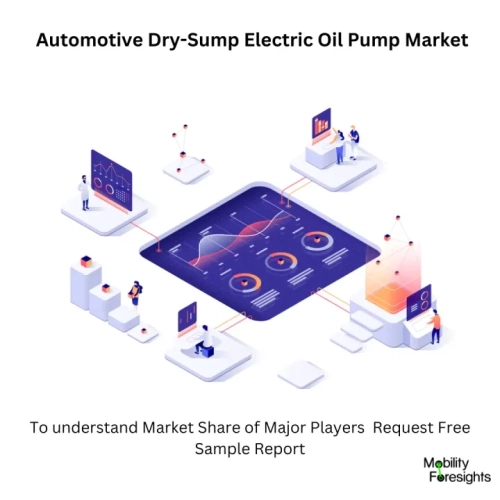
- Get in Touch with Us

Last Updated: Apr 25, 2025 | Study Period:
The automotive dry-sump electric oil pump market is experiencing dynamic growth, driven by advancements in vehicle technology and increasing demands for efficiency and performance. Dry-sump systems, known for their ability to enhance lubrication and cooling, are becoming increasingly popular in high-performance and electric vehicles. These systems offer significant advantages over traditional wet-sump configurations, including improved oil management, reduced weight, and enhanced engine reliability.
The market is influenced by the rising popularity of performance-oriented vehicles and the shift toward electric mobility, which necessitates sophisticated lubrication solutions to support advanced drivetrains. However, the market also faces challenges, such as high initial costs and installation complexities, which can deter some manufacturers from adopting these systems.
Despite these hurdles, the long-term outlook remains positive, fueled by ongoing technological innovations and regulatory pressures aimed at reducing emissions and improving fuel efficiency. As automakers increasingly focus on sustainability and performance, the demand for dry-sump electric oil pumps is expected to grow, positioning this segment for significant expansion in the coming years.
The automotive industry is undergoing a transformative phase, with a growing emphasis on performance, efficiency, and sustainability. At the forefront of this evolution is the dry-sump lubrication system, particularly the electric oil pump variant, which has emerged as a critical component in high-performance and electric vehicles. Unlike traditional wet-sump systems, dry-sump configurations allow for better oil control, improved cooling, and reduced weight, making them increasingly attractive for modern automotive applications.
As manufacturers strive to enhance engine performance and meet stringent emissions regulations, the demand for innovative lubrication solutions is on the rise. Electric oil pumps, in particular, offer several advantages, including reduced parasitic drag and improved energy efficiency, aligning well with the industryâs shift toward electrification. This introduction sets the stage for a deeper exploration of the factors driving the growth of the automotive dry-sump electric oil pump market, the challenges it faces, and its future prospects in a rapidly changing automotive landscape.

| Company Name | Product Description | Analyst View |
| Bosch | Bosch has launched a lightweight electric oil pump specifically designed for high-performance engines, enhancing oil flow and cooling efficiency. | This product positions Bosch strongly in the high-performance segment, catering to sports and electric vehicles. |
| Aisin Seiki | Aisin Seiki introduced a compact dry-sump electric oil pump that integrates smart technology for real-time monitoring of oil pressure and temperature. | The incorporation of smart technology is a significant advancement, improving reliability and efficiency. |
| Parker Hannifin | Parker has developed a high-efficiency electric oil pump that features advanced materials for reduced weight and increased durability. | This innovation addresses industry demands for lightweight components, enhancing overall vehicle performance. |
| Gates Corporation | Gates unveiled a modular dry-sump electric oil pump system that allows for customizable configurations to suit various vehicle types. | The modular approach provides flexibility for manufacturers, making it easier to implement in diverse applications. |
| Carter Automotive | Carter's new electric oil pump utilizes variable speed technology to optimize oil flow based on engine performance needs. | This product is aligned with current trends in efficiency, offering improved performance while minimizing energy consumption. |
By Livestock Type
By Feed Type
By Ingredients
By Distribution Channel
| Sr. No. | Topic |
| 1 | Market Segmentation |
| 2 | Scope of the Report |
| 3 | Research Methodology |
| 4 | Executive Summary |
| 5 | Introduction |
| 6 | Average B2B Price |
| 7 | Regional Analysis and Trends |
| 8 | Impact of Technological Advancements on The global automotive dry-sump electric oil pump market |
| 9 | Demand Technology Trends in the Industry |
| 10 | Major Key Drivers in the Market |
| 11 | Recent Product Developments |
| 12 | Manufacturing Footprint for Major Players |
| 13 | Recent Orders in the global automotive dry-sump electric oil pump market |
| 14 | Market Dynamics and Strategic Initiatives |
| 15 | Analysis of The Global automotive dry-sump electric oil pump market Initiatives on Market Growth |
| 16 | Impact of Sustainable Practices on Market Trends |
| 178 | Market Size, Dynamics, and Forecast by Livestock Type, 2024-2030 |
| 18 | Market Size, Dynamics, and Forecast by Feed Type, 2024-2030 |
| 19 | Market Size, Dynamics, and Forecast by Ingredients, 2024-2030 |
| 20 | Market Size, Dynamics, and Forecast by Distribution Channel, 2024-2030 |
| 21 | Pricing Strategies and Market Positioning |
| 22 | Competitive Landscape |
| 23 | M&A in the Past 12 Months |
| 24 | Growth Strategy of Leading Players |
| 25 | Market Share of Vendors, 2024 |
| 26 | Company Profiles |
| 27 | Unmet Needs and Opportunity for New Suppliers |
| 28 | Conclusion |